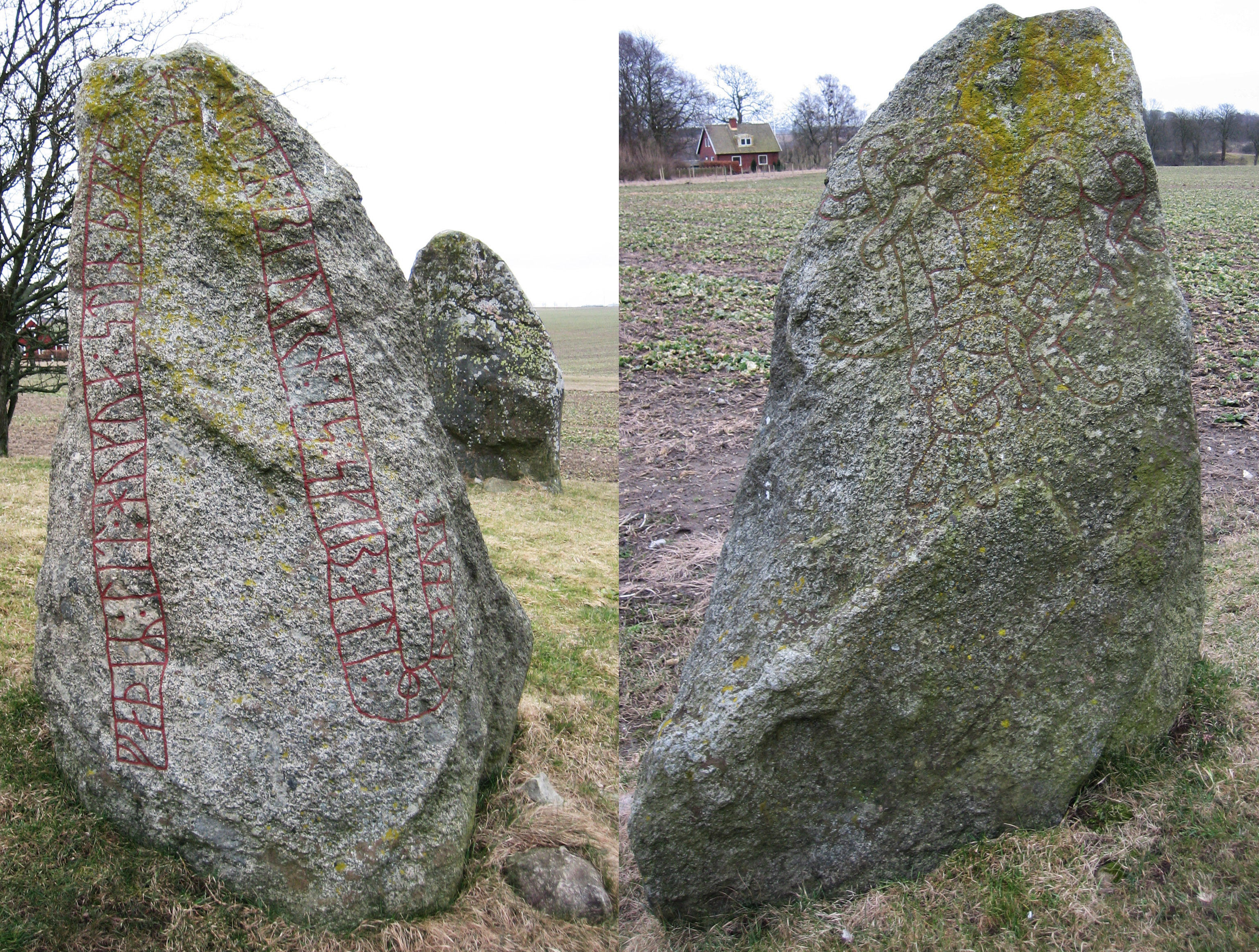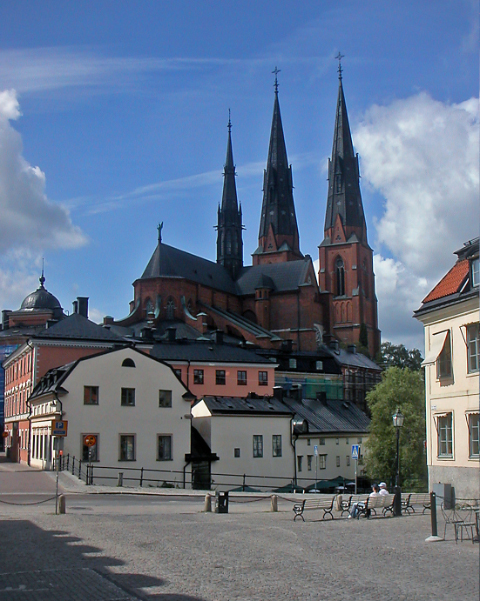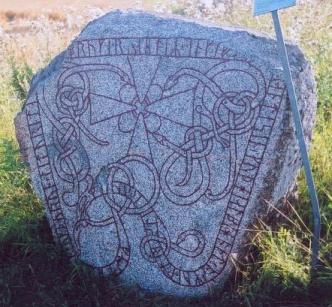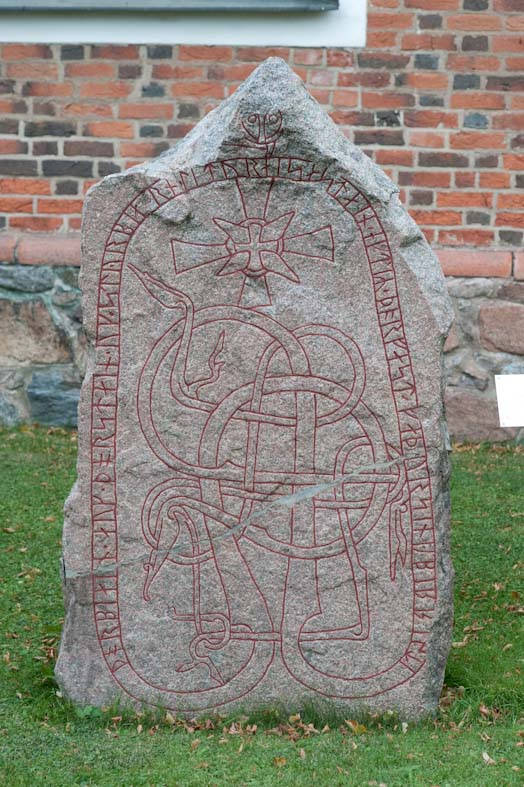|
Uppland Runic Inscription 824
Uppland Runic Inscription 824 is the Rundata catalog number for a Viking Age memorial runestone located at Holms, which is about eight kilometers east of Örsundsbro, Uppsala County, Sweden, and in the historic province of Uppland. The inscription features a facial mask and a bind rune in the text. Description This inscription consists of runic text carved on a serpent that is intertwined with and encircles other serpents. The inscription is classified as being carved in either runestone style Pr3 or Pr4, both of which are considered to be Urnes style. This runestone style is characterized by slim and stylized animals that are interwoven into tight patterns. The animal heads are typically seen in profile with slender almond-shaped eyes and upwardly curled appendages on the noses and the necks. At the top of the inscription but within the outer serpent is a mask of a man's face. This is a common motif and is found on several other runestones including DR 62 in Sjelle, DR 66 in ... [...More Info...] [...Related Items...] OR: [Wikipedia] [Google] [Baidu] |
U 824, Holms
U or u, is the twenty-first and sixth-to-last Letter (alphabet), letter and fifth vowel letter of the Latin alphabet, used in the English alphabet, modern English alphabet, the alphabets of other western European languages and others worldwide. Its name in English is English alphabet#Letter names, ''u'' (pronounced ), plural English alphabet#Letter names, ''ues''. History U derives from the Semitic Waw (letter), waw, as does F, and later, Y, W, and V. Its oldest ancestor goes to Egyptian hieroglyphs, Egyptian hieroglyphics, and is probably from a hieroglyph of a mace or fowl, representing the sound [Voiced labiodental fricative, v] or the sound [Voiced labial–velar approximant, w]. This was borrowed to Phoenician, where it represented the sound [w], and seldom the vowel [Close back rounded vowel, u]. In Greek language, Greek, two letters were adapted from the Phoenician waw. The letter was adapted, but split in two, with the Digamma, first one of the same name (Ϝ) being ada ... [...More Info...] [...Related Items...] OR: [Wikipedia] [Google] [Baidu] |
Västra Strö 2 Runestone
The Västra Strö 2 Runestone, listed as DR 335 in the Rundata catalog, is a Viking Age memorial runestone located at the Västra Strö Monument, which is at a church that is about four kilometers northwest of Eslöv, Skåne County, Sweden. Description The Västra Strö Monument consists of five standing stones and two runestones, DR 355 and the Viking runestone DR 334. The two stones have a Danish Rundata catalog number because Scania was part of the historical Denmark during the Viking Age. The monument was surveyed in the 17th century by the Danish antiquarian Ole Worm who documented the inscriptions and reported that it was in good condition. This was not the case during a second survey in 1876 when all stones except one were found to have fallen. The Lund Kulturen restored the monument in 1932. When the stone was raised in 1932, a mask of a man's face was discovered on the other side. This is a common motif and is found on several other runestones including DR 62 in ... [...More Info...] [...Related Items...] OR: [Wikipedia] [Google] [Baidu] |
Uppsala Cathedral
Uppsala Cathedral ( sv, Uppsala domkyrka) is a cathedral located between the University Hall of Uppsala University and the Fyris river in the centre of Uppsala, Sweden. A church of the Church of Sweden, the national church, in the Lutheran tradition, Uppsala Cathedral is the seat of the Archbishop of Uppsala, the primate of Sweden. It is also the burial site of King Eric IX (c. 1120–1160, reigned 1156–1160), who became the patron saint of the nation, and it was the traditional location for the coronation of new Kings of Sweden. The current archbishop is Martin Modéus and the current bishop is Karin Johannesson. The cathedral dates to the late 13th century and, at a height of , it is the tallest church in the Nordic countries. Originally built under Roman Catholicism, it was used for coronations of Swedish monarchs for a lengthy period following the Protestant Reformation. Several of its chapels were converted to house the tombs of Swedish monarchs, including Gustav Vas ... [...More Info...] [...Related Items...] OR: [Wikipedia] [Google] [Baidu] |
Uppland Runic Inscription 871
U 871 is a 12th-century runestone in the Rundata catalog, originally from Ölsta, a village in the county of Uppland in Sweden. It is now on display at Skansen, near Stockholm. Description It is believed that this stone remained in its original place until 1896. The spot was close to the Eriksgata, the road that the Swedish king travelled after having been elected at the Stone of Mora, in order to be accepted by his subjects. The stone was sold for 50 Swedish kronor in 1896 to the founder of Skansen, Artur Hazelius, where it was moved. It remains at Skansen to this day. The inscription is classified as being carved in runestone style Pr4, which is also known as the Urnes style. This runestone style is characterized by slim and stylized lindworms that are interwoven into tight patterns. The animal heads are typically seen in profile with slender, almond-shaped eyes and upwardly curled appendages on the noses and the necks. The inscription is signed by the runemaster Åsmund Kåre ... [...More Info...] [...Related Items...] OR: [Wikipedia] [Google] [Baidu] |
Baltic Area Runestones
The Baltic area runestones are Varangian runestones in memory of men who took part in peaceful or warlike expeditions across the Baltic Sea, where Finland and the Baltic states are presently located. Beside the runestones treated in this article and in the main article Varangian runestones, there are many other runestones that talk of eastward voyages such as the Greece runestones, Italy runestones, and inscriptions left by the Varangian Guard. Other runestones that deal with Varangian expeditions include the Ingvar runestones (erected in honor or memory of those who travelled to the Caspian Sea with Ingvar the Far-Travelled). In addition, there were also voyages to Western Europe mentioned on runestones that are treated in the articles Viking runestones, England runestones and Hakon Jarl runestones. Below follows a presentation of the runestones based on the Rundata project. The transcriptions into Old Norse are mostly in the Swedish and Danish dialect to facilitate comp ... [...More Info...] [...Related Items...] OR: [Wikipedia] [Google] [Baidu] |
Åsmund Kåresson
Åsmund Kåresson was a Viking Age runemaster who flourished during the first half of the 11th century in Uppland and Gästrikland, Sweden. The early Urnes style is represented in his art. pp. 197, 208–09. Work Most early medieval Scandinavians were probably literate in runes, and most people probably carved messages on pieces of bone and wood.Vilka kunde rista runor?' on the Swedish National Heritage Board website, retrieved January 13, 2007. However, it was difficult to make runestones, and in order to master it one also needed to be a stonemason. During the 11th century, when most runestones were raised, there were a few professional runemasters. Åsmund was active mainly in Uppland, and about twenty runestones are signed by him and an additional thirty stones have been attributed to him. The ornamentation is characterized by variation with firmness and security in the composition. Åsmund is the inventor of the classic Uppland runestone style with one or two animals (''rundjur ... [...More Info...] [...Related Items...] OR: [Wikipedia] [Google] [Baidu] |
Runemaster
A runemaster or runecarver is a specialist in making runestones. Description More than 100 names of runemasters are known from Viking Age Sweden with most of them from 11th-century eastern Svealand.The article ''Runristare'' in ''Nationalencyklopedin'' (1995). Many anonymous runestones have more or less securely been attributed to these runemasters. During the 11th century, when most runestones were raised, there were a few professional runemasters. They and their apprentices were contracted to make runestones and when the work was finished, they sometimes signed the stone with the name of the runemaster. Many of the uncovered runic inscriptions have likely been completed by non-professional runecarvers for the practical purposes of burial rites or record-keeping. Due to the depictions of daily life, many of the nonprofessional runecarvers could have been anything from pirates to soldiers, merchants, or farmers. The layout of Scandinavian towns provided centers where craftspeople ... [...More Info...] [...Related Items...] OR: [Wikipedia] [Google] [Baidu] |
Younger Futhark
The Younger Futhark, also called Scandinavian runes, is a runic alphabet and a reduced form of the Elder Futhark, with only 16 characters, in use from about the 9th century, after a "transitional period" during the 7th and 8th centuries. The reduction, somewhat paradoxically, happened at the same time as phonetic changes that led to a greater number of different phonemes in the spoken language, when Proto-Norse evolved into Old Norse. Also, the writing custom avoided carving the same rune consecutively for the same sound, so the spoken distinction between vowel length, long and short vowels was lost in writing. Thus, the language included distinct sounds and minimal pairs that were written the same. The Younger Futhark is divided into long-branch (Danish) and short-twig (Swedish and Norwegian) runes; in the 10th century, it was further expanded by the "Hälsinge Runes" or staveless runes. The lifetime of the Younger Futhark corresponds roughly to the Viking Age. Their use decl ... [...More Info...] [...Related Items...] OR: [Wikipedia] [Google] [Baidu] |
Sjellebro Stone
The Sjellebro Stone is a Viking Age image stone located at Sjellbro, which is about 12 kilometers southeast of Randers, Denmark. The stone is inscribed with a facial mask. Description The Sjellbro Stone is about 1.7 meters in height and features the facial mask of a man. Similar to other image stones, today it is difficult to determine the meaning of the inscription. The facial mask on this granite stone is a common motif and is found on several Scandinavian runestones including DR 62 in Sjelle, DR 66 in Århus, DR 81 in Skern, DR 258 in Bösarp, the now-lost DR 286 in Hunnestad, DR 314 in Lund, DR 335 in Västra Strö, Vg 106 in Lassegården, Sö 86 in Åby ägor, Sö 112 in Kolunda, Sö 167 in Landshammar, Sö 367 in Släbro, Nä 34 in Nasta, U 508 in Gillberga, U 670 in Rölunda, U 678 in Skokloster, U 824 in Holms, U 1034 in Tensta, and U 1150 in Björklinge. Of these mask stones, the Sjellebro Stone is the only one without any runic inscription. The Sjellebro Stone ... [...More Info...] [...Related Items...] OR: [Wikipedia] [Google] [Baidu] |
Uppland Runic Inscription 1034
Uppland Runic Inscription 1034 or U 1034 is the Rundata catalog number for a runic inscription on a runestone located at the Tensta Church, which is three kilometers northwest of Vattholma, Uppsala County, Sweden, and in the historic province of Uppland, that was carved in the late 11th or early 12th century. While the tradition of carving inscriptions into boulders began in the 4th century and lasted into the 12th century, most runestones date from the late Viking Age. Description The runic inscription states that it was ''Øpiʀ risti'' ("Öpir carved"), indicating that it was carved by the runemaster Öpir, who was active in the late 11th or early 12th century. The inscription is carved in runestone style Pr5, also known as the Urnes style. This runestone style is characterized by slim and stylized animals that are interwoven into tight patterns. The animal heads are typically seen in profile with slender almond-shaped eyes and upwardly curled appendages on the noses and the n ... [...More Info...] [...Related Items...] OR: [Wikipedia] [Google] [Baidu] |
Uppland Runic Inscription 678
U 678 is the Rundata catalog number for a Viking Age image stone with a runic inscription located in Skokloster, Uppland, Sweden. Description This runestone was found walled inside a church at Skokloster, and has been moved to a location behind the church. One side of the stone has an image of a man on a horse, and the other side has a similar image with a surrounding runic inscription within runic bands. At the top of the second side with the runic text is carved a man's mask above a Christian cross. Other runestones with a similar mask above a cross motif include inscriptions on Södermanland Runic Inscription 86, Sö 86 in Åby, Sö 112 in Kolunda, Södermanland Runic Inscription 367, Sö 367 in Släbro, Nasta Runestone, Nä 34 in Nasta, and Uppland Runic Inscription 1034, U 1034 in Tensta. Other inscriptions with facial masks include DR 62 in Sjelle, Skern Runestone, DR 81 in Skern, the now-lost Hunnestad Monument, DR 286 in Hunnestad, Lund 1 Runestone, DR 314 in Lund, Vg 106 i ... [...More Info...] [...Related Items...] OR: [Wikipedia] [Google] [Baidu] |






